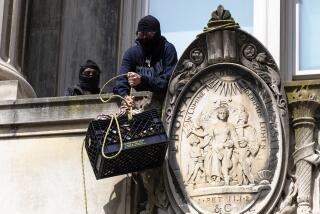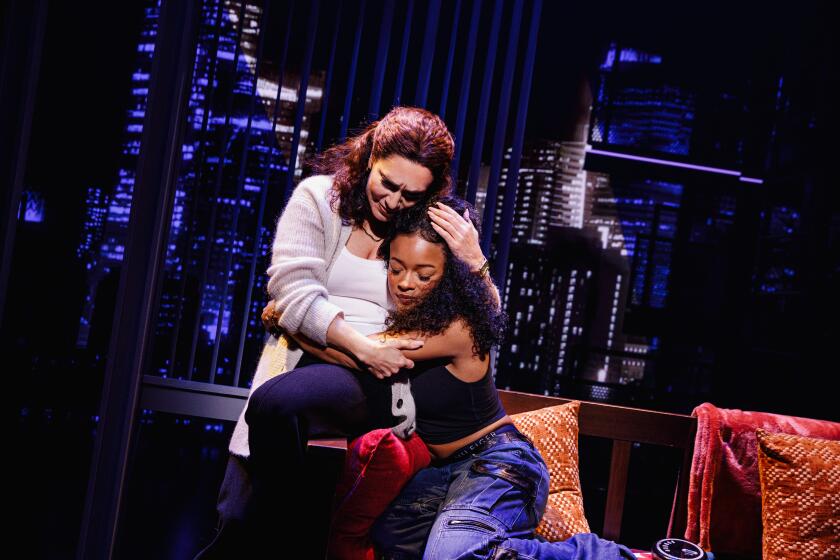‘Genius of Kitsch’ Has His Say on Meaning of 9/11
Zurab Tsereteli, the court sculptor whose work decorates the capital, is used to being derided by critics and rivals as the king of kitsch. At 69, he sails on a sea of controversy, his ego billowing like a wind-filled spinnaker that no criticism can deflate.
Though his work often raises hackles on his home turf, it is his latest project that is roiling the waves in two countries. Tsereteli’s memorial to the Sept. 11 terrorist attacks in the U.S. -- a 100-foot splintered pylon with a giant teardrop-shaped glob of glass that he says will exude drops like real tears -- will soon be built on the Jersey City waterfront.
Whether from sour grapes or plain disbelief at Tsereteli’s success, some in the Russian art and architecture world see the planned monument as evidence that the taste of U.S. public officials can be as questionable as that of Moscow’s leaders.
David Sarkisian, director of the Shchusev State Scientific Research Museum of Architecture in Moscow, said he believed Tsereteli, whose work is displayed in 18 countries, had “done more harm to Moscow’s appearance than anybody else has ever done.”
“Tsereteli is a genius of kitsch. He is the personification of kitsch,” Sarkisian said. “It is only his limitless energy and push that have helped him get his ugly sculptures put up all over the world. In that sense, Zurab Tsereteli is a world champion in terms of the number of ugly works he has managed to palm off to different countries.
“It is simply beyond comprehension how he manages to be so successful,” he said.
A proud, extravagant figure, Tsereteli wears a huge gold watch, suspenders and gold sleeve bands. A large metal key lies on his desk, the key to Jersey City. He dismisses his detractors as ignoramuses who don’t understand high culture.
“I’m one of those artists who gives birth to ideas and sees them through to the end,” he said. “I want my works to live for a long time, and I really wish my works to be appreciated by everyone. But if everyone likes your works, it’s a tragedy.”
He outlined his vision for the Sept. 11 monument: “There are tears of sorrow and tears of joy. That’s the main concept. I am sure that the tears will be tears of joy very soon,” he said, predicting the defeat of terrorism.
A jumble of ideas compete for attention in Tsereteli’s Moscow studio. Paintings cover the wall and are stacked in piles while models of statues and sculptures in different styles cover the floor. His office, equally chaotic, is stuffed with miniatures, knickknacks and photographs of the artist with famous and powerful people. His staff flutters and twitters around like birds on one of his statues.
Under the patronage of Mayor Yuri M. Luzhkov, Tsereteli has left his mark all over Moscow, sometimes evoking outrage. The so-called Moscow Style imposed on the city by Luzhkov has been described in World Architecture magazine as “an abysmal rhetoric of traditional architectural elements, re-created Disney-style in poor-quality materials and with no attention to detail.”
One of those responsible for that “flamboyantly ornate style” was Tsereteli, ensconced as a “quasi-official sculptor and architect,” another World Architecture article noted. Critics have been especially unkind to his 165-foot, goggle-eyed Peter the Great statue on the banks of the Moscow River, branding it as a desecration of the skyline. A group of political extremists once threatened to blow it up, but Tsereteli said he firmly believed it to be a city favorite.
“I’m the kind of artist who knows what he’s doing,” he said. The opposition to Peter the Great was “all political, from people who have vanished into oblivion. A lot of people made mistakes in their criticisms [of it]. It’s high culture to know and understand art.”
Tsereteli created the “Good Defeats Evil” sculpture of St. George at the United Nations. His 350-foot Christopher Columbus, created in 1991, was his most controversial work, rejected by at least five U.S. cities, including New York, before it was accepted five years ago by Puerto Rico. Like much of Tsereteli’s work, it was a gift from the artist, although the transport of thousands of pieces cost the taxpayers about $30 million, and it has still not been erected.
The 660-ton work was mired in scandal for its height, cost and historical inaccuracy, depicting Columbus at a ship’s wheel, not the tiller of his day. The statue had to be shortened by 50 feet to accommodate landing planes, and there was more anger when houses were destroyed to make way for the statue.
“This is where Columbus actually entered America. He didn’t go straight to Fifth Avenue, did he?” Tsereteli said, as though Puerto Rico was his first choice for the site.
An early model of the Sept. 11 work consisted of an enormous bronze eagle fighting a dragon, surrounded by a forest of 190 pylons 150 feet high, each with its own big glass teardrop. Another model was a four-sided edifice with water running down wires, with symbols of Christianity, Islam, Judaism and Buddhism.
Tsereteli was not named last December as one of seven finalists to adorn the World Trade Center site. So he took his proposal across the river to Jersey City, a move he says was advantageous for his sculpture because “if it was in New York itself, it would be hidden by buildings and no one would see it.”
He says he has abandoned all other work to meet the deadline, next Sept. 11. He calls the monument a personal gift, while a Jersey City spokesman said it was donated by the Russian government, Tsereteli and the Federation of Russian Artists. That the Tsereteli monument was donated was a major factor in its selection, the spokesman said.
Stan Eason, spokesman for the New Jersey City mayor, said the city held a competition and that a committee, including members of the public, selected the best work. “His was definitely the best on offer,” Eason said. But the fact that the Russian government and Tsereteli were financing the work played a role.
Eason said he was unaware of any controversy over Tsereteli. “One man’s art is another man’s nightmare. You know, art is so interpretive. I’m sure Leonardo da Vinci was probably criticized for some of his works.
Tsereteli said the mayor of Jersey City was “flabbergasted, and everyone was in delight. They stopped me in the street to tell me how great it was.”
Mikhail Chemiakin, a New York-based Russian artist, said being a sculptor was a tough job. People who reviled Tsereteli’s “Peter the Great” in Moscow should try making something themselves, he said.
He said Tsereteli should not take offense when people described his work as kitsch, because “in the U.S., kitsch is the kind of big art that some people get paid lots of money for.”
Grigory Revzin, a prominent Moscow art critic, of the Kommersant daily newspaper, said that all criticism was subjective and that “I personally do not like anything about Tsereteli’s sculptures. Indeed, quite a few people in Russia don’t much like Tsereteli and his works.”
Revzin said there was very little good sculpture to be found in the world nowadays, including in America. “To be honest, most of the sculptures erected in the U.S. are bad,” he said.
More to Read
Start your day right
Sign up for Essential California for news, features and recommendations from the L.A. Times and beyond in your inbox six days a week.
You may occasionally receive promotional content from the Los Angeles Times.






